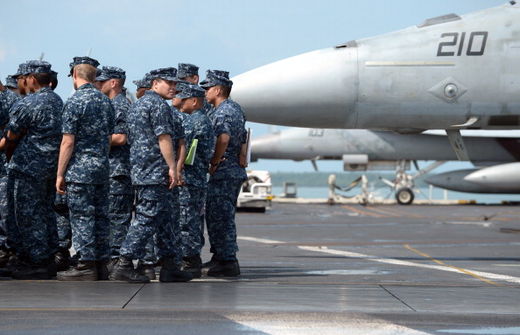
The Virginian-Pilot reports that Navy officials released findings of a December test that found their standard uniforms are not designated flame-resistant, and will burn "robustly until completely consumed" when subjected to flames.
"We knew when we designed this uniform that it wasn't flame-resistant," Rear Adm. John Kirby, the Navy's top spokesman, told the paper. "When we were making the uniform, sailors wanted a uniform that was comfortable, that didn't require maintenance and would stand up under a lot of washing, and one of the ways to get that is a nylon-cotton blend."
Kirby added that there was no requirement for a fire-resistant uniform in the Navy's working environment.
The Type I NWU uniform is half cotton and half nylon. According to the report, the nylon component "is a thermoplastic fiber that melts and drips as it burns." The uniform was never meant to be flame-retardant and there is fire gear throughout any ship in case sailors are exposed to flames. Only sailors with specific jobs such as airman, engineer or firefighter and those in combat are required to have fire-resistant clothing, Navy admirals told the Virginian-Pilot.
The working uniform tests were conducted in research on materials and equipment at the Navy safety center in Massachusetts. Kirby told the Virginian-Pilot that one of the testers took it upon himself to check out the flammability of the NWU material.
The Navy posted a video online that shows the uniform quickly burning when exposed to flames.
"Nobody asked for these tests," Kirby told the Virginian-Pilot. "Now that we have the results of this particular test - obviously, we are not surprised the fabric did not react well to flame - but now that we have specifics... we are going to take another look."
An editorial published by the Navy Times last week entitled, "For safety's sake, fix NWU mess - fast" charged that uniforms were not only unsafe, but that the Navy was "misleading people about this uniform" since it was introduced in 2005.
The paper discovered a Navy posting in an online forum that states, "Navy uniforms are required to meet specific fire retardant standards, and these NWU concepts also meet those requirements."
Vice Adm. Scott Van Buskirk, Chief of Naval Personnel and president of the Navy's Uniform Board, announced in a message to commanders last month that working groups have been established to review the fleet's uniform needs and to consider whether these uniforms can do the job.



But it's YOU who doesn't love Vets!
R.C.